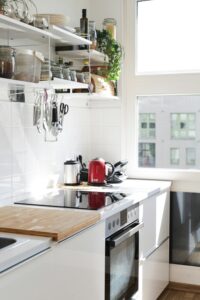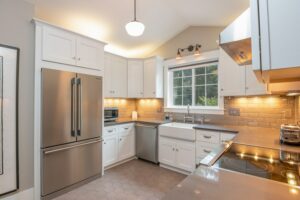Appliance controls and knobs may seem like small and insignificant parts of our everyday appliances, but they play a crucial role in their functionality. These controls and knobs allow us to adjust settings, select options, and operate our appliances with ease. Without them, our appliances would be rendered useless. Therefore, it is important to understand the basics of appliance controls and knobs, as well as how to troubleshoot and replace them when necessary. Additionally, proper maintenance and care of these components can help prolong the lifespan of our appliances.
Key Takeaways
- Appliance controls and knobs are essential for operating appliances
- Common problems with control panels and knobs include wear and tear, damage, and malfunction
- Troubleshooting involves identifying the issue and determining the best course of action
- Diagnosing problems may require testing and inspection of the appliance
- Tools and equipment needed for replacement include screwdrivers, pliers, and replacement parts
Understanding the basics of appliance controls and knobs
Appliance controls and knobs come in various types, depending on the appliance they are used for. Some common types include push buttons, dials, touchscreens, and sliders. These controls allow us to adjust temperature, select cooking modes, set timers, and perform other functions specific to each appliance. Understanding how these controls work is essential for proper operation of our appliances.
For example, a dial control typically operates by turning it clockwise or counterclockwise to increase or decrease the desired setting. Push buttons may require a simple press or a combination of presses to activate certain functions. Touchscreens rely on touch-sensitive technology to register inputs. By familiarizing ourselves with the different types of controls and knobs on our appliances, we can effectively operate them and make the most out of their features.
Common problems with appliance control panels and knobs
Like any other component, control panels and knobs can experience issues over time. Some common problems include unresponsive controls, loose knobs, cracked panels, and malfunctioning displays. These issues can greatly affect the performance of our appliances and make them difficult or even impossible to use.
Unresponsive controls can be frustrating as they prevent us from adjusting settings or selecting options. Loose knobs can lead to inaccurate adjustments or even fall off completely. Cracked panels not only affect the aesthetics of our appliances but can also compromise their functionality. Malfunctioning displays can make it difficult to read important information such as temperature or time.
Troubleshooting control panel and knob issues
| Issue | Cause | Solution |
|---|---|---|
| Control panel not responding | Loose connections, faulty wiring, or damaged control panel | Check connections, replace wiring, or replace control panel |
| Knob not turning | Loose or damaged knob, faulty mechanism | Tighten or replace knob, repair or replace mechanism |
| Knob turning but not adjusting settings | Loose or damaged mechanism, faulty sensor | Repair or replace mechanism, replace sensor |
| Control panel displaying error message | Software malfunction, faulty sensor or wiring | Reset software, replace sensor or wiring |
When faced with control panel and knob problems, it is important to troubleshoot the issues to identify the root cause. Start by checking the power supply to ensure that the appliance is receiving electricity. If the controls are unresponsive, try resetting the appliance by unplugging it for a few minutes and then plugging it back in. This simple step can often resolve minor issues.
If the controls or knobs are loose, tighten them carefully using a screwdriver or other appropriate tool. For cracked panels, consider replacing them to prevent further damage and ensure proper functionality. Malfunctioning displays may require professional repair or replacement.
How to diagnose control panel and knob problems
To diagnose control panel and knob problems, it is important to first identify the specific issue. Start by observing the behavior of the controls and knobs. Are they completely unresponsive or only partially functioning? Are there any error messages or unusual sounds? Take note of any patterns or recurring issues.
Next, consult the appliance’s user manual for troubleshooting tips specific to your model. The manual may provide guidance on common issues and how to resolve them. If the manual does not provide a solution, consider reaching out to the manufacturer’s customer support for further assistance.
Tools and equipment needed for control panel and knob replacement

If control panel or knob replacement is necessary, you will need a few tools and equipment to successfully complete the task. The specific tools required may vary depending on the appliance and its design, but some common tools include screwdrivers (both flathead and Phillips), pliers, wire cutters/strippers, and a multimeter for testing electrical connections.
It is important to use the appropriate tools for the job to avoid damaging the appliance or causing injury. If you are unsure about which tools to use or how to use them, consult the appliance’s user manual or seek professional assistance.
Step-by-step guide to replacing control panels and knobs
Replacing control panels and knobs can be a relatively straightforward process if you follow the proper steps. Here is a general step-by-step guide:
1. Turn off the power: Before starting any work, make sure to disconnect the appliance from the power source to avoid electrical shock.
2. Remove the old control panel or knob: Depending on the appliance, this may involve unscrewing it, gently prying it off, or disconnecting any electrical connections.
3. Disconnect any electrical connections: If necessary, carefully disconnect any wires or connectors attached to the control panel or knob. Take note of their positions or take a picture for reference when installing the new component.
4. Install the new control panel or knob: Follow the manufacturer’s instructions for installing the new component. This may involve connecting wires, aligning screw holes, or snapping it into place.
5. Reconnect any electrical connections: If you disconnected any wires or connectors, carefully reconnect them according to their original positions.
6. Secure the new control panel or knob: Use screws or other appropriate fasteners to secure the new component in place.
7. Restore power and test: Once everything is securely in place, restore power to the appliance and test the new control panel or knob to ensure proper functionality.
Tips for selecting the right replacement parts
When selecting replacement parts for control panels and knobs, it is important to choose ones that are compatible with your specific appliance model. Consult the appliance’s user manual or contact the manufacturer for information on compatible replacement parts.
Additionally, it is recommended to use high-quality replacement parts to ensure durability and proper functionality. Cheap or generic parts may not fit properly or may not last as long as genuine parts. Investing in high-quality replacement parts can save you time and money in the long run.
Preventing control panel and knob problems in the future
To prevent control panel and knob problems in the future, it is important to practice regular maintenance and care for your appliances. Keep the controls and knobs clean by wiping them down regularly with a damp cloth. Avoid using abrasive cleaners or harsh chemicals that can damage the surfaces.
Additionally, be mindful of how you handle the controls and knobs. Avoid excessive force or rough handling that can cause them to become loose or damaged. If you notice any issues, such as loose knobs or unresponsive controls, address them promptly to prevent further damage.
Maintaining and caring for your appliances
In addition to maintaining the controls and knobs, it is important to properly care for your appliances as a whole. Regularly clean the interior and exterior of your appliances to remove dirt, grease, and food particles that can affect their performance. Follow the manufacturer’s instructions for cleaning specific parts or components.
It is also important to use appliances according to their intended purpose and capacity. Overloading an appliance or using it for tasks it is not designed for can lead to premature wear and tear, as well as potential safety hazards.
When to call in a professional for control panel and knob replacement
While some control panel and knob replacements can be done by homeowners, there are instances when it is best to call in a professional. If you are unsure about your ability to safely replace these components or if the appliance is still under warranty, it is recommended to seek professional assistance.
Professional technicians have the knowledge, experience, and tools necessary to safely replace control panels and knobs. They can also diagnose any underlying issues that may be causing the problems and provide appropriate solutions.
Appliance controls and knobs may seem like small parts, but they are essential for the proper operation of our appliances. Understanding how these controls work, troubleshooting common issues, and knowing how to replace them when necessary can help us maintain the functionality of our appliances. By practicing regular maintenance and care, we can prevent control panel and knob problems in the future and prolong the lifespan of our appliances. When in doubt, it is always best to seek professional assistance to ensure safety and expertise.
If you’re experiencing issues with your knob or control panel and need help identifying and fixing them, check out this informative article from 911 Appliance. They provide expert advice on troubleshooting common problems and offer solutions to ensure your appliances are working properly. Don’t let a faulty knob or control panel disrupt your daily routine – learn how to address these issues with the help of 911 Appliance’s comprehensive guide. For more information, visit their website at https://911Appliance.com/our-blog/.
How Can I Troubleshoot and Replace the Control Panel on My Appliances?
When dealing with troubleshooting control panel solutions for your appliances, start by checking for loose or damaged wiring. If the control panel needs to be replaced, disconnect the power supply and remove the old panel. Install the new panel following the manufacturer’s instructions to ensure proper function.
Can Noisy Knobs or Controls Lead to the Need for Replacement?
If you notice unusual sounds coming from your knobs or controls, it’s crucial to address the issue promptly. Identifying and fixing sounds early can prevent further damage and the need for complete replacement. Ignoring the noises could lead to more extensive and expensive repairs down the line.



